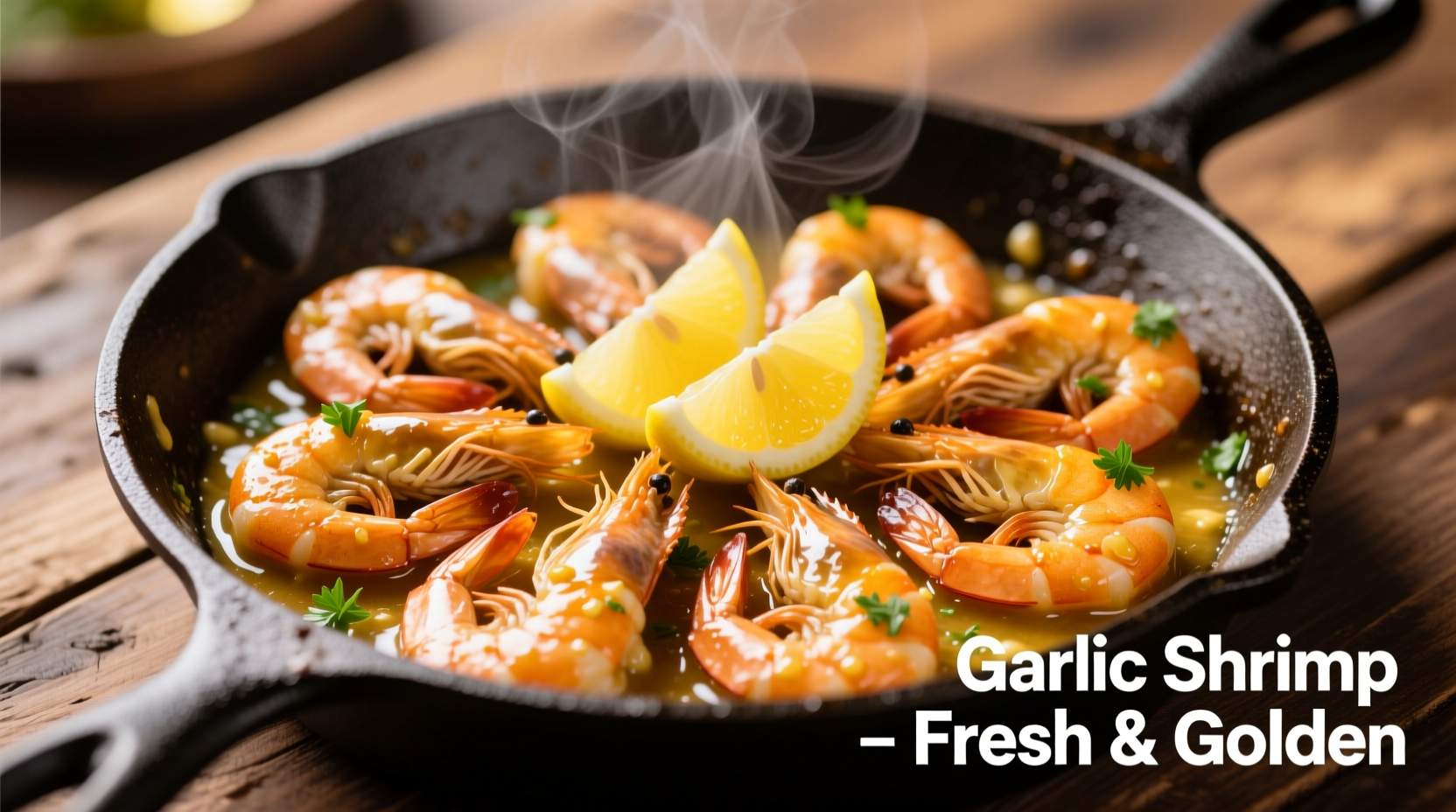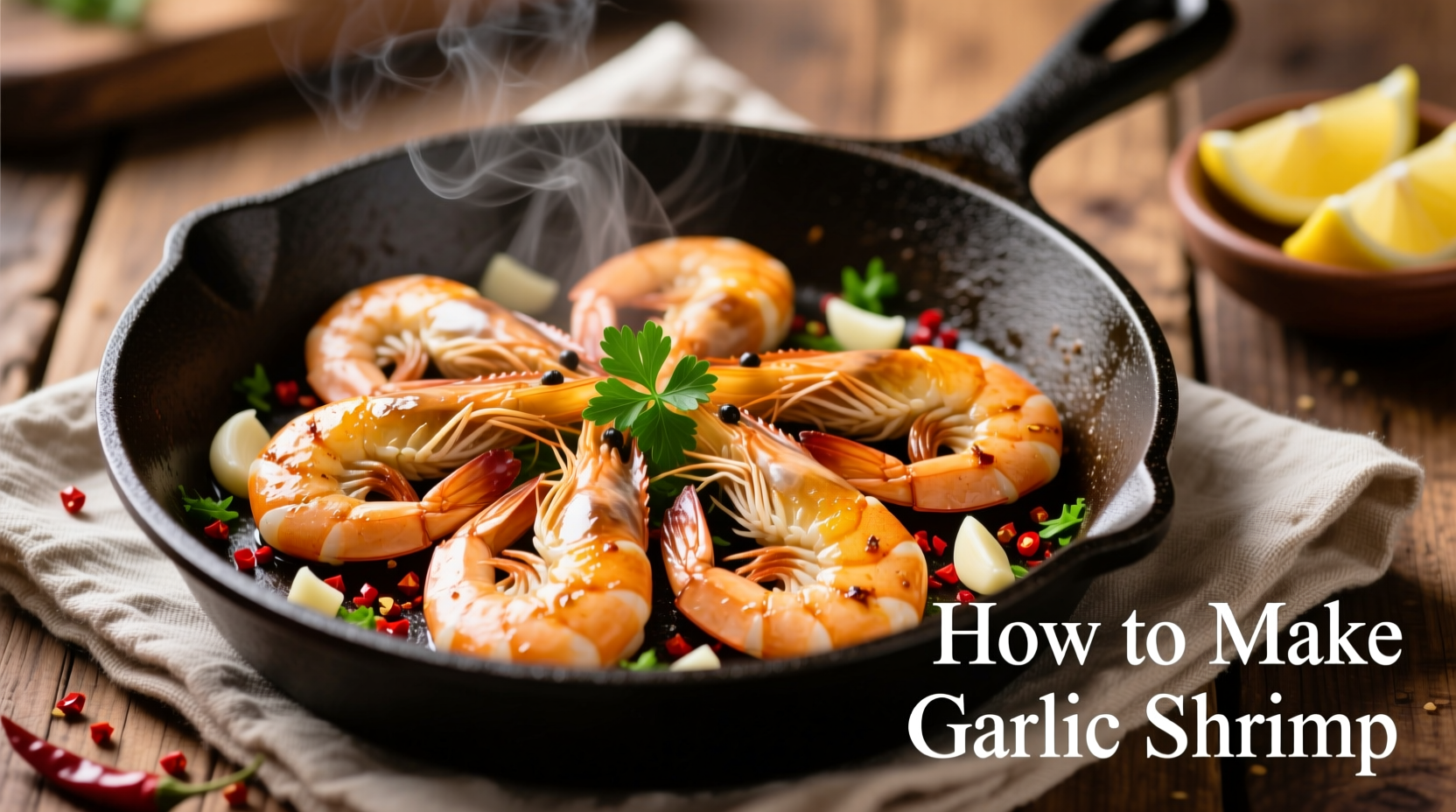Make restaurant-quality garlic shrimp in just 15 minutes with this simple recipe: Sauté 1 lb of peeled shrimp in 2 tbsp olive oil with 4 minced garlic cloves, 1/2 tsp red pepper flakes, and juice of 1 lemon for 2-3 minutes per side until pink and opaque. Finish with fresh parsley and serve immediately over pasta or with crusty bread.
If you're searching for how to make garlic shrimp that rivals your favorite restaurant's version, you've found the right guide. This foolproof method delivers tender, flavorful shrimp with perfectly balanced garlic notes every time. As a chef who's prepared this dish hundreds of times across Mediterranean kitchens, I've refined the technique to eliminate common pitfalls like rubbery texture or burnt garlic.
Why This Garlic Shrimp Recipe Works
Garlic shrimp seems simple, but proper technique makes all the difference. The key is controlling heat and timing - shrimp cook incredibly fast and become tough when overcooked. This method uses medium-high heat for perfect searing without burning the garlic, which can turn bitter in seconds.
| Prep Time | Cook Time | Total Time | Servings |
|---|---|---|---|
| 5 minutes | 8 minutes | 13 minutes | 2-3 |
Essential Ingredients for Perfect Garlic Shrimp
The magic of this easy garlic shrimp recipe comes from quality ingredients and proper ratios. Don't skip the brine step - it's crucial for plump, juicy results.
Shrimp Selection Guide
According to the U.S. Food and Drug Administration, proper shrimp selection impacts both safety and quality:
- Size: 21-25 count per pound (medium-large) works best for even cooking
- Form: Fresh or properly thawed frozen (never cook frozen shrimp)
- Smell: Should have mild ocean scent, not strong ammonia odor
- Color: Translucent grayish-green, not yellow or gritty
Complete Ingredient List
- 1 pound medium-large shrimp (21-25 count), peeled and deveined
- 1 tablespoon kosher salt (for brine)
- 1 quart cold water
- 2 tablespoons extra-virgin olive oil
- 4 large garlic cloves, finely minced
- 1/2 teaspoon red pepper flakes (adjust to taste)
- 1 tablespoon unsalted butter
- Juice of 1 medium lemon (about 2 tablespoons)
- 2 tablespoons fresh parsley, finely chopped
- 1/4 teaspoon freshly ground black pepper
- Optional: 1/4 cup dry white wine for deglazing

Step-by-Step Cooking Instructions
Preparation Phase (3 minutes)
- Create a brine: Dissolve 1 tbsp salt in 1 quart cold water. Submerge shrimp for 15 minutes - this NOAA-approved technique improves moisture retention
- Pat shrimp completely dry with paper towels (critical for proper searing)
- Prepare garlic by mincing finely (not using pre-minced garlic for best flavor)
Cooking Process (5 minutes)
- Heat olive oil in large skillet over medium-high heat until shimmering (about 2 minutes)
- Add shrimp in single layer, cooking 2-3 minutes per side until pink and opaque
- Remove shrimp immediately to prevent overcooking
- Reduce heat to medium, add garlic and red pepper flakes, sauté 30-60 seconds until fragrant but not browned
- Return shrimp to pan, add butter, lemon juice, and optional wine
- Toss to coat, cook 1 minute until sauce emulsifies
- Remove from heat, stir in parsley and black pepper
Pro Chef Techniques for Best Results
Avoid these common mistakes when learning how to cook garlic shrimp perfectly:
Garlic Preparation Comparison
| Method | Flavor Profile | Cooking Time | Best For |
|---|---|---|---|
| Raw minced | Sharp, pungent | 30-60 seconds | Quick sautés |
| Sliced | Milder, sweeter | 1-2 minutes | Longer cooking dishes |
| Whole cloves | Subtle, nutty | 5+ minutes | Slow-cooked sauces |
- Don't overcrowd the pan: Cook in batches if necessary - crowded shrimp steam instead of sear
- Control garlic browning: Add garlic after shrimp are removed to prevent burning
- Perfect timing: Total cooking time should never exceed 8 minutes for 1 lb shrimp
- Sauce thickness: If sauce is too thin, simmer 30 seconds longer; if too thick, add 1 tbsp water
Serving Suggestions and Variations
This quick garlic shrimp dinner pairs beautifully with:
- Zucchini noodles for low-carb option
- Crusty bread for soaking up the delicious sauce
- Over angel hair pasta with a sprinkle of Parmesan
- Alongside roasted asparagus or green beans
Regional Variations Timeline
Garlic shrimp has evolved across Mediterranean cuisines:
- 1950s: Simple Spanish gambas al ajillo with olive oil and dried chili
- 1970s: Italian adaptation adding white wine and parsley
- 1990s: American restaurants incorporating lemon and butter
- Today: Global fusion versions with herbs, spices, and citrus variations
Food Safety Considerations
According to the USDA Food Safety and Inspection Service, proper seafood handling is critical:
- Cook shrimp to internal temperature of 145°F (63°C)
- Never leave cooked shrimp at room temperature more than 2 hours
- Refrigerate leftovers within 2 hours of cooking
- Consume leftovers within 3-4 days
Troubleshooting Common Problems
Fix these issues when making garlic shrimp at home:
- Rubbery texture: Overcooking is the culprit - reduce time by 30 seconds per side
- Bitter garlic: Garlic burned - lower heat next time and add garlic later
- Watery sauce: Shrimp wasn't patted dry - always dry thoroughly before cooking
- Dry shrimp: Skipped the brine step - never skip this moisture-retention technique
Storage and Reheating Instructions
For best quality when making garlic shrimp ahead of time:
- Refrigerate in airtight container for up to 3 days
- Reheat gently in skillet with 1 tsp water or broth (not microwave)
- Never freeze cooked shrimp - texture becomes rubbery
- For meal prep: Store components separately and combine when reheating











 浙公网安备
33010002000092号
浙公网安备
33010002000092号 浙B2-20120091-4
浙B2-20120091-4